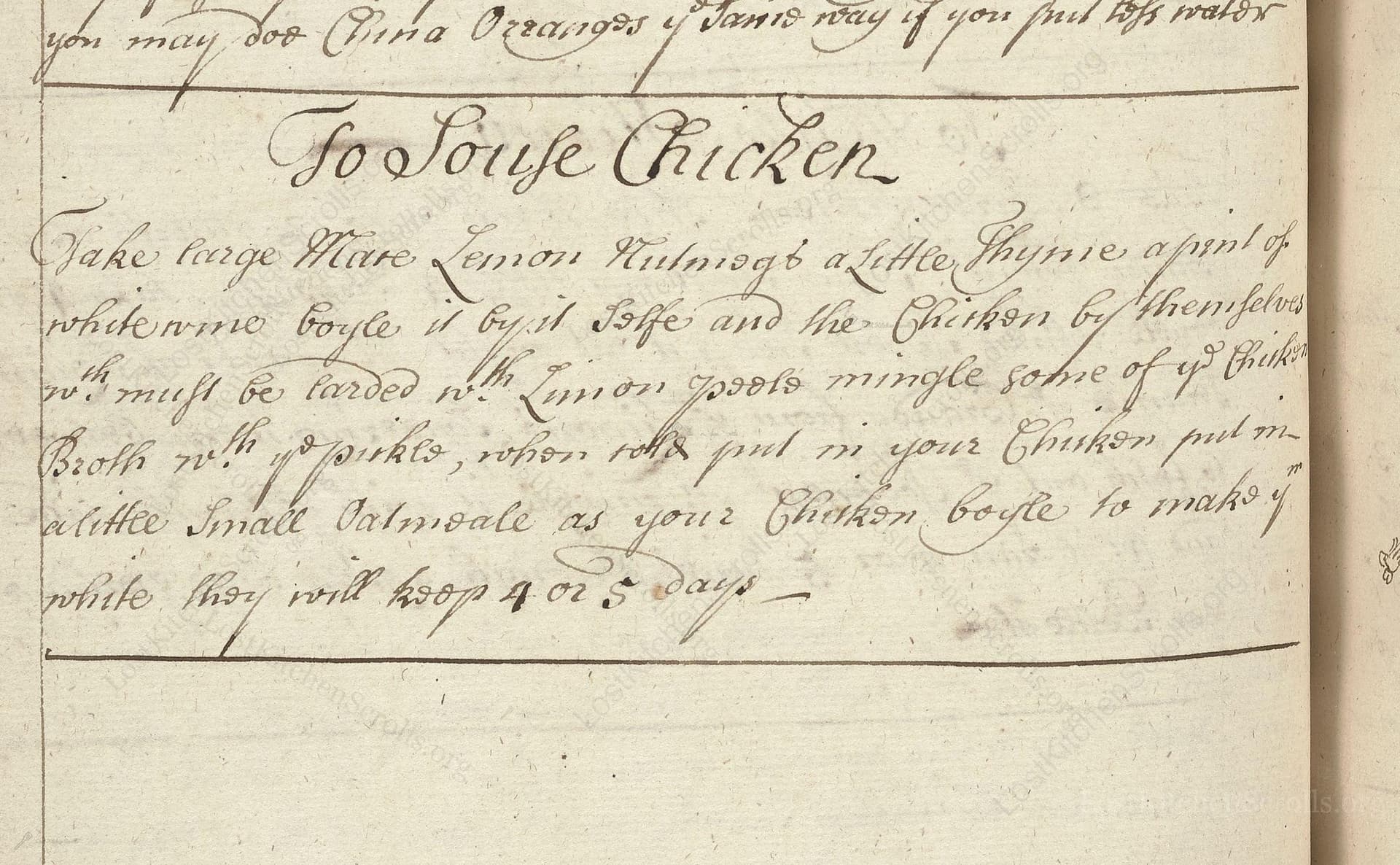To Souse Chicken
From the treasured pages of Cookbook of Grace Blome, Kent
Written by Grace Randolph

To Souse Chicken
"Take large Hens Kidneys a little Thyme a pint of whitwine boyle it by it selfe and the Chicken by themselves you must be sure to skum your pott mingle some of ye Chicken broth wt your picklo, when cold put in your Chiken put in Oatmeale as your Chiken boyle to make ye picklo white they will keep 4 or 5 days_"
Note on the Original Text
The recipe is composed in terse, direct language, with minimal punctuation and inconsistent spelling typical of handwritten English household books from the 17th century. Terms like 'skum your pott' and 'picklo' refer to skimming the pot and making a pickle or brine, respectively. 'Boyle it by it selfe' means to cook the kidneys (or offal) in their own liquor, separate from the chicken. The style assumes familiarity with basic cookery, omitting precise measurements and relying on the cook’s judgement—an expected skill for those charged with kitchen affairs in Grace Randolph’s day.

Title
Cookbook of Grace Blome, Kent (1697)
You can also click the book image above to peruse the original tome
Writer
Grace Randolph
Era
1697
Publisher
Unknown
Background
A delightful glimpse into late 17th-century kitchens, this culinary collection by Grace Randolph tempts taste buds with refined recipes and elegant flavors fit for a well-to-do English household. Journey through a banquet of historic treats and timeless techniques!
Kindly made available by
Folger Shakespeare Library
This recipe comes from an English household manuscript dated 1697, attributed to Grace Randolph. During the late 17th century, sousing—preserving meat in a tart, wine-based brine or pickle—was a common preparation for both storage and flavor. Such recipes were written for household cooks managing both procurement and preservation, and would particularly suit grander homes with the means to purchase wine and keep poultry. The finished dish, brisk and sharp with wine and scented with thyme, was enjoyed cold over several days, reflecting both preservation needs and evolving tastes for more refined, complex flavors in Restoration and early Georgian England.

In the late 17th century, most kitchens would utilize a large hearth with hanging cauldrons or pots for boiling. Large earthenware or copper pots were used to boil chicken and prepare the pickling liquor. Simple metal or wooden spoons served for skimming scum from the broth, and chops or cleavers to break down the chicken. The finished souse would go into glazed earthenware or stoneware dishes to stay cool, often in a cellar or larder before refrigeration.
Prep Time
20 mins
Cook Time
1 hr
Servings
4
We've done our best to adapt this historical recipe for modern kitchens, but some details may still need refinement. We warmly welcome feedback from fellow cooks and culinary historians — your insights support the entire community!
Ingredients
- 2 large chicken kidneys (or 3.5 oz chicken livers as a substitute)
- 1 teaspoon (about 0.1 oz) fresh thyme, chopped
- 2 cups dry white wine
- 1 whole chicken (about 3.5 lbs)
- Water, enough to cover the chicken in the pot
- 2 tablespoons (about 0.5 oz) fine oat flour or ground oats
- Salt to taste
Instructions
- Start by taking 2 large hen kidneys (or substitute with chicken livers, as kidneys are not commonly available today) and a small handful (about 1 teaspoon chopped) of fresh thyme.
- Place them in a saucepan with 2 cups of dry white wine and bring gently to a simmer, allowing them to cook through, then set aside.
- Separately, boil a whole chicken (about 3.5 lbs) in a large pot filled with water.
- Skim off any scum that rises to keep the broth clear.
- Once the chicken is cooked through and tender, remove it from the pot and let both chicken and broth cool.
- To make the pickling liquid (pickle), mix some of the chicken broth with the wine and kidneys/liquor once both have cooled.
- Add a small amount of fine oat flour or ground oats (about 2 tablespoons) as the original recipe mentions oatmeale—this will help keep the pickling liquor white and slightly thickened.
- Finally, return the cooled pieces of chicken to this pickling mixture and store in a shallow ceramic or glass dish in the fridge.
- The chicken will keep for 4-5 days, developing more flavor as it sits.
Estimated Calories
350 per serving
Cooking Estimates
Preparing this dish will take about 20 minutes, as you chop herbs, prepare livers or kidneys, and get the chicken ready for boiling. Cooking time includes simmering the organs in wine and boiling the whole chicken until it is tender, which takes about 1 hour. This recipe makes enough for 4 servings, with each serving containing about 350 calories.
As noted above, we have made our best effort to translate and adapt this historical recipe for modern kitchens, taking into account ingredients nowadays, cooking techniques, measurements, and so on. However, historical recipes often contain assumptions that require interpretation.
We'd love for anyone to help improve these adaptations. Community contributions are highly welcome. If you have suggestions, corrections, or cooking tips based on your experience with this recipe, please share them below.
Join the Discussion
Rate This Recipe
Dietary Preference
Culinary Technique
Occasions

Den Bockfisch In Einer Fleisch Suppen Zu Kochen
This recipe hails from a German manuscript cookbook compiled in 1696, a time whe...

Die Grieß Nudlen Zumachen
This recipe comes from a rather mysterious manuscript cookbook, penned anonymous...

Ein Boudain
This recipe comes from an anonymous German-language manuscript cookbook from 169...

Ein Gesaltzen Citroni
This recipe, dating from 1696, comes from an extensive anonymous German cookbook...
Browse our complete collection of time-honored recipes



